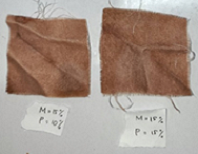Utilization of Tamarind Seeds Extract as a Natural and Sustainable Fabric Dye
Abstract
This research focuses on the use of tannin components in tamarind seed coats as a mordant and natural dye in cotton fabrics. Tannins were extracted from the tamarind seed coat by boiling method and then the tannin content was determined. The tannin extract was then used as a natural mordant with the addition of metallic copper sulfate (CuSO4) mordant. Tannin extract is also used as a dye on fabrics with the addition of sodium sulfate (NaSO4). The color strength of the tannins in the fabric was analyzed using a spectrophotometer from the rinse water. The results showed that the cloth that had been given the mordant had a stronger color strength than the cloth without the mordant. The use of mordant was varied at concentrations of 5, 10, 15, 20, and 25%-owf. The results of the analysis showed the most optimum tannin concentration at 15%-owf. The concentration of tannin used in the coloring process was also varied at concentrations of 5, 10, 15, 20, and 25%-owf. The results of the analysis show that the concentration of tannin used in the dye does not affect the strength of the color, but only affects the brightness of this color.
Downloads

Copyright (c) 2024 Astri Nur Istyami, Muhammad Arif, Muhammad Ilham Azzindi, Meiti Pratiwi, Sanggono Adisasmito, Nuning Yanti Damayanti, Agus Tendi Ahmad Bustomi, Jenny Rizkiana

This work is licensed under a Creative Commons Attribution-NonCommercial-NoDerivatives 4.0 International License.
Authors who publish with this journal agree to the following terms:
- Copyright on any article is retained by the author(s).
- The author grants the journal, the right of first publication with the work simultaneously licensed under a Creative Commons Attribution License that allows others to share the work with an acknowledgment of the work’s authorship and initial publication in this journal.
- Authors are able to enter into separate, additional contractual arrangements for the non-exclusive distribution of the journal’s published version of the work (e.g., post it to an institutional repository or publish it in a book), with an acknowledgment of its initial publication in this journal.
- Authors are permitted and encouraged to post their work online (e.g., in institutional repositories or on their website) prior to and during the submission process, as it can lead to productive exchanges, as well as earlier and greater citation of published work.
- The article and any associated published material is distributed under the Creative Commons Attribution-NonCommercial-NoDerivatives 4.0 International License.





_copy1.png)










